#The third Reich
Text


Before The Fall, 2004, written and directed by Dennis Gansel (German: Napola - Elite für den Führer, literally "Napola – The Führer's Elite). Napola colloquially for Nationalpolitischen Erziehungsanstalt (National political educational institution)
#before the fall#napola#dennis gansel#tom schilling#2000s movies#year: 2004#das dritte reich#the third reich#nazis#elite schools#military academy#nazi elite school#nazi elite academy#elite academy#military school#military schools and academies
60 notes
·
View notes
Text
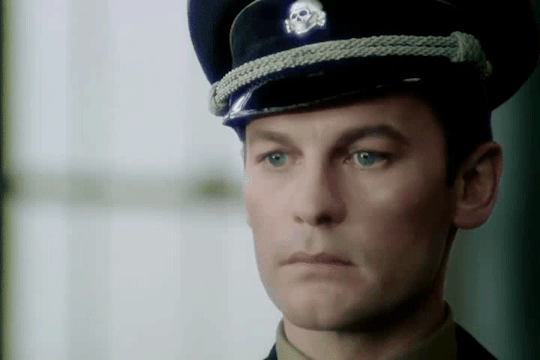


HELMUT BERGER in Salon Kitty (1976)
22 notes
·
View notes
Photo

Late last year the slogan Один народ. Одна история. Одна страна! (One people. One history. One country!) began appearing in Russia. This is part of a propaganda effort by the régime to convince the population that Russia and Ukraine are really the same country and therefore Putin’s genocidal invasion was not really an invasion.
Of course taking action to deny the existence of another people is one of the hallmarks of genocide.
If Один народ. Одна история. Одна страна! sounds familiar, that’s because Nazi Germany made frequent use of the slogan Ein Volk, Ein Reich, Ein Führer (One People, One Empire, One Leader) as it was gorging itself on nearby territories. While not identical, the Russian slogan is clearly in the same spirit as the Nazi one.
The banner with the Russian slogan in the picture on top is above the entrance to the railway station in the city of Nizhny Novgorod. It was published, with pictures of similar signs, on the Telegram channel of The Village.
This is yet another similarity between Russia and Nazi Germany.
In Russia these days you can get sent to the gulag for comparing the Putin régime to the Hitler régime. It’s ironic that this is exactly the sort of thing the Nazis would do. So Putin proves that his critics are correct.
#invasion of ukraine#similarity between nazi germany and putin's russia#the third reich#russia is a terrorist state#vladimir putin#putin is a war criminal#genocide#nizhny novgorod#один народ. одна история. одна страна!#лозунг#нижний новгород#вокзал#пропаганда#владимир путин#путлер#геноцид#путинский рейх#путин хуйло#военные преступления#путин – это лжедмитрий iv а не пётр великий#геть з україни#вторгнення оркостану в україну#україна переможе#путінський рейх#слава україні!#героям слава!
6 notes
·
View notes
Photo







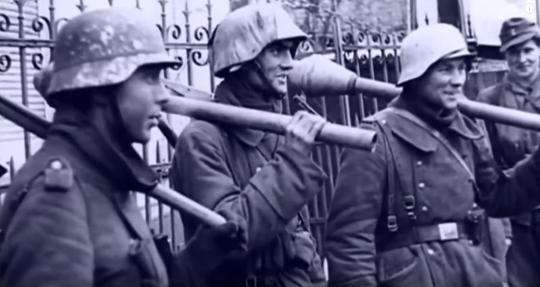
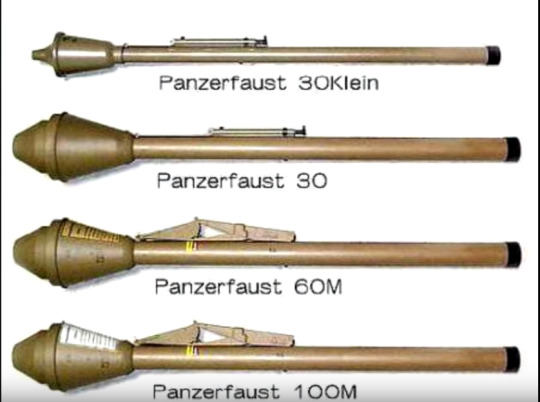

Panzerfaust 3: The Cold War Weapon Wrecking Russian Tanks in Ukraine
Though the Russian Army was once vaunted as the second-best military in the modern world, the greatly underestimated Ukrainian military has showed it up again and again, seemingly with only national pluck and a hodgepodge of donated weapons from sympathetic Western countries.
Among the borrowed Ukrainian arsenal, the Panzerfaust 3 has made an impressive showing against Russian armored columns. What is this shoulder-fired antitank rocket, where did it come from, and why is it striking fear into Vladimir Putin’s soldiers?
The Panzerfaust originated in World War II
In 1943, with a resurgent Soviet army advancing on the Third Reich behind a phalanx of first-class tanks being produced in numbers that Germany has no hope of matching, Germany developed a small, simple, easy to use antitank weapon that could turn any wielder into a tank killer. Called the Panzerfaust (“armor fist”), it was essentially a tube that launched a rocket-propelled grenade with a shaped charge capable of penetrating armor at ranges up to 200 feet. The launching tube could be reloaded if extra warheads were available, but inexpensive enough to be discarded if they were not.
Distributed among soldiers and, as of Oct. 18, 1944, to hastily trained elders and children of the Volkssturm (“people’s storm,” Nazi Germany’s last-ditch national militia), the Panzerfaust required extraordinary courage to operate at its effective range and was not reliable enough to save the Reich from its ultimate doom on May 8 (or May 9, depending on who you ask) the next year.
It became a Cold War staple
It was, however, effective enough for postwar armies on either side of Iron Curtain to make improvements on its basic design. That includes the current German Bundeswehr (Federal Armed Forces) in the form of the Panzerfaust 3. After entering combat in Afghanistan with the Bundeswehr, the new generation of Panzerfausts is again battling Russian tanks … except that the people wielding the antitank weapons are Ukrainian.
In response to a 1973 order for a more powerful, accurate semi-disposable weapon to replace the World War II-vintage PzF-44, capable of engaging the latest generation of Russian T-72 and T-80 tanks, the Dynomit Nobel Allgemeine Gesellschaft worked on this latest version of the antitank rocket from 1978 to 1995, though the Panzerfaust 3 was accepted by the Bundeswehr in 1992.
The modern Panzerfaust 3 is a tank-killing machine
It has since undergone technical upgrades to keep up with improvements in tanks, especially the Panzerfaust 3-T, which uses a dual hollow-charge tandem warhead, with a spike on the front of the warhead that can set off reactive armor and in so doing free a path for the main charge to reach and penetrate up to 31.5 inches of steel armor. As a further improvement, the Panzerfaust 3-IT600 gets its designation from the user’s ability to engage enemy armored vehicles at up to 600 meters by using a Simrad Optonics sighting-and-targeting mechanism.
Once fired, the warhead is sent on its way by a spring, but after about 16.5 feet, the rocket motor ignites and the safety disengages, allowing the warhead to explode on contact with its target. The warhead also contains plastic granulate that work on the recoilless countermass principle to virtually eliminate backblast.
The Panzerfaust 3-IT600 is 3 feet, 11 inches long and weighs 34 pounds, 6 ounces, of which 8 pounds, 10 ounces is the 110mm-diameter (4.3-inch diameter) warhead with Amatol/Sindal high explosive. Up to 29 pounds, 5 ounces of spare rounds can be carried by the operator.
With a muzzle velocity of 499 feet per second, the warhead has a maximum effective range of 1,312 feet on a stationary target and 1,968.5 feet against a moving target. Minimum effective range (without the debris of an exploding target endangering the user) is 65.6 feet.
Can a Panzerfaust 3 take on a Russian T-90?
These capabilities pale beside the 125mm (4.9-inch) main gun with a 1.86-mile range on Russia’s latest main battle tank, the T-90, in an open battlefield. As with the original PzF-44, however, Panzerfaust 3 operated on uneven ground, forested areas or urban environments by trained, motivated troops can be every bit as deadly as designed.
Once under full production, the original Panzerfaust 3 cost $9,994, but the IT-600 version costs $11,108 apiece because of its computerized sight. A standard antitank round costs $297, but there is also a Bunkerfaust (“bunker fist”) round for use against static enemy positions. That costs $202.
As of 2003, 261,718 Panzerfaust 3s have been produced. In 1989, Japan became the first foreign power to purchase the weapon, followed by Switzerland in 1991. Since then, it has also entered the arsenals of Austria, Italy, the Netherlands, Peru, South Korea Iraq and Mauritius. Ukraine added its name to that list when Russian forces invaded it in February 2022 and a variety of sympathetic Western powers began supplying weapons — including the Panzerfaust 3 — to bolster Ukraine’s defenses. Thus far, the Ukrainians have been putting them to very good use, much to the expense of a growing number of Russian armor crews.
By Jon Guttman.
#Panzerfaust 3: The Cold War Weapon Wrecking Russian Tanks in Ukraine#2022 russian invasion of ukraine#2022 russia-ukraine news#ukraine#russia#germany#The Panzerfaust#anti tank weapons#the third reich#nazi germany#war#world at war#weapons
7 notes
·
View notes
Text

Five thousand New Yorkers gathered in Columbus Circle in a mass demonstration against the persecution of Jews and Catholics by Germany, November 16, 1938. The crowd heard denunciations of the Third Reich from several speakers, including Nathan Frankel, Labor Advisor to Mayor La Guardia, and Orson Welles.
Photo: Associated Press
#vintage New York#1930s#demonstration#protest#Nazi Germany#Third Reich#Nov. 16#16 Nov.#anti-Nazi#vintage NYC
139 notes
·
View notes
Text
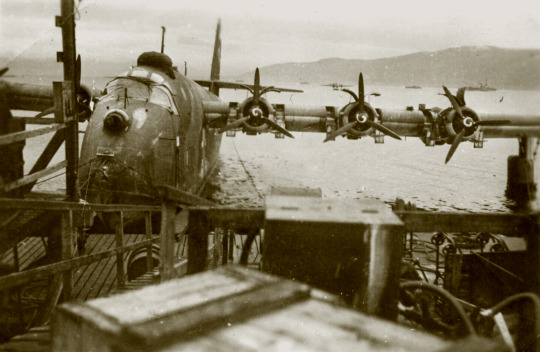
Blohm & Voss BV 222 Wiking under tow by Royal Navy forces, Trondheim harbour, Norway, possibly 8 May 1945. For more, see my Facebook group - Eagles Of The Reich
#germany#ww2#luftwaffe#ww2 aircraft#blohm & voss#bv222#bv 222 wiking#ww2 flying boats#flying boat#norway#third reich#nazi germany
61 notes
·
View notes
Text
NOOO! THE BABIES!!!
other links:
#funny#countryballs#countryballscomic#countryhumans#countryball#polandball#germanyball#germany#west germany#east germany#third reich#ussr#america#countryhumans ussr#countryhumans america#joke#baby
35 notes
·
View notes
Text
fuck zodiac signs what's your favorite game changer episode?
#ALL SEASONS pick one#mine is official cast recording#second is probably escape the greenroom#third is honestly the button#first episode really set the tone for the whole damn show#gamechanger#game changer#dropout tv#dropout#dropouttv#sam reich#ive just never stopped thinking about mountport i love that whole universe#and i never want a sequel#ringotheman#text post
34 notes
·
View notes
Text
The Two Ministers: Galeazzo Ciano and Joachim von Ribbentrop
Probably the one of the two most interesting figures. Since I make researches mostly on Fascist Italy, it was intriguing to read Galeazzo Ciano's perspective and thoughts on Joachim von Ribbentrop, his German colleague Minister. One thing is certain: both men didn't like each other. It was a huge despise from both parties.
Ciano thought of Ribbentrop as a "too cynical and suck up" kind of man. Meanwhile, Ribbentrop considered Ciano as a "hiding traitor, playing the double-agent role for the democratic countries".
Fun fact: Galeazzo Ciano's diaries were used by the Allies as a proof against Joachim von Ribbentrop in the Nuremberg Trials.
-----
On May 22, 1939, the Kingdom of Italy and Nazi Germany entered into the Pact of Steel signed by their respective Foreign Ministers Galeazzo Ciano and Joachim von Ribbentrop. This agreement was greeted with great enthusiasm by the press: "unfailing friendship between our two peoples." Ciano wrote in his diary, a few days after his execution in January 1944: "The tragedy of Italy began in August 1939. On my own initiative, I went to Hitler's headquarters in Salzburg and was suddenly confronted with the cold and cynical Germanic determination to provoke the conflict. The alliance between Italy and Germany had been signed in May. I had opposed it, making every effort to delay such a step, or at least make it ineffective. There was no reason, on the other hand, in my opinion, to bind oneself for life and death to the fate of Nazi Germany. I had favored, it is true, a policy of cooperation, because of our geographic location, because we can and should detest, but not ignore that eighty million Germans brutally burden the heart of Europe. The decision to cement the alliance was made suddenly by Mussolini, while I was in Milan with Ribbentrop. Several American newspapers had published that the Lombard metropolis had welcomed the Reich Foreign Ministry with blatant hostility, and this was evidence of Mussolini's diminished personal prestige. He was in a state of rage. By telephone he ordered me to accept the German demands for an alliance, which I had held in abeyance for more than a year and hoped to send off again. Thus was born the "Pact of Steel." This decision, which was then to have such a disastrous influence on the life and future of the Italian people, was due solely to a spiteful reaction on the part of the dictator to certain rash and baseless statements in some foreign newspapers." Actually Mussolini is worried because subsequent to the Pact of Steel the Nazis assure him that they do not want to wage war for the time being, but he is beginning to be not so sure. Italy in 39' is completely depleted, exhausted by the Ethiopian War and the intervention in Spain on the side of Franco, later the winner of the civil war. Despite the positive outcome, wars cost huge sums of money and the Italian budget suffers greatly; entering a world war in this condition would be difficult to sustain. Galeazzo Ciano, Foreign Minister as well as Mussolini's son-in-law, writes in his diary in early August, "the time has come to see how things stand: the game is too big."
On August 11 Ciano flies to Germany, is sent to von Ribbentrop with instructions to explain to him that to wage war at that time would be madness. On the question of Poland, the Kingdom Minister asks his peer, "do you want Danzig?" von Ribbentrop replies, "not anymore, we want war." Later, during the reception, Ciano approaches one of his aides and says in his ear, "we are at blows." Ciano, worried, wonders if the Germans have considered the likely intervention of England and France and how they intend to deal with them. But Ribbentrop is sure, they will not dare to intervene, Germany will invade Poland and have a free field. It is a bet on the non-intervention of the Western powers, as in 1914, when Kaiser Wilhelm's Germany invaded Belgium sure of no consequences from England. This time they really make the bet: von Ribbentrop proposes to Ciano that if England and France stayed out then Italy would give Germany a Renaissance painting; if not, Germany would give Italy a collection of ancient German weapons. But Ribbentrop is sure: "We will wage war and it will not become a world war, because France and England will not dare to intervene."
Ciano returns to Rome, and it is now clear that the Nazis are about to invade Poland, as well as that Hitler expects Fascist Italy, as declared at the 1937 Berlin Assembly by Mussolini, to march with its ally all the way. But the Führer does not know that Italy is prepared to hold out to avoid imminent catastrophe given the weakness of the army. When the Duce finally comes forward and confesses his country's total unpreparedness, the Germans first turn up their noses, then they are fine with it as long as Italy's neutrality is not flaunted too much around. On September 1, 1939, Germany invaded Poland triggering the tremendous conflict that for six years displayed the greatest atrocities in human history. Italy would enter it about a year later when during the famous Piazza Venezia speech on June 10, 1940, Mussolini announced that "The declaration of war has already been delivered to the ambassadors of Great Britain and France." It was "the hour of irrevocable decisions" that led Mussolini and the Fascist regime to its fall.
--------
Sources: Alessandro Barbero, Galeazzo Ciano's Diaries.
QOD: What do you think about Galeazzo Ciano and Joachim von Ribbentrop?
-------
Photos:




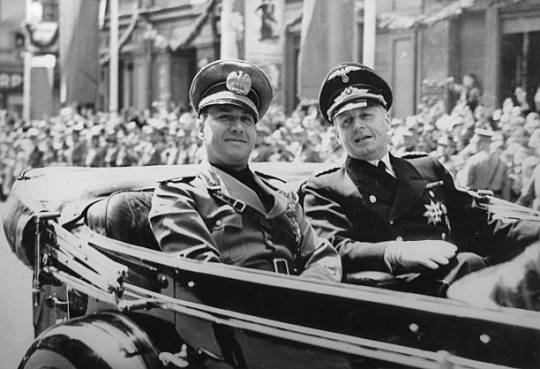
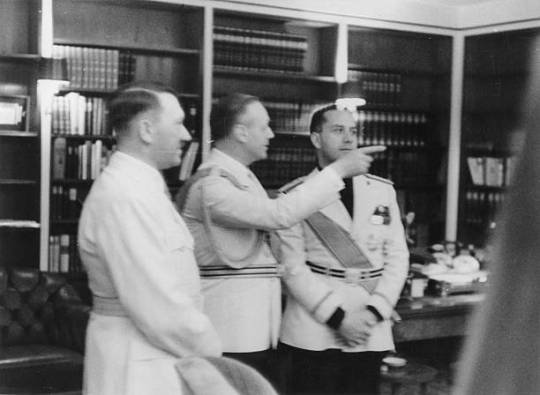
#reichblr#ww2#wwii#ww2 italy#ww2 germany#third reich#3rd reich#fascist italy#galeazzo ciano#ciano#joachim von ribbentrop#von ribbentrop#historical#historical figures#1940s
30 notes
·
View notes
Text
just remembered that during the corruption arc (which was two years ago holy shit) sherbert made a tiktok using audio from brennan lee mulligan's yes or no monologue. i wonder if they were going "tee hee they don't know :)" while filming that.
#fable smp#sherbertquake56#yesterday's premiere has me thinking about the many torments of brennan lee mulligan#combine that with the constant background thinking about fable and you get this#for those of you who are more normal and don't have that monologue committed to memory#about a third of it revolves around the myth of icarus#specifically an interpretation where the wings are a plot to get rid of icarus#like his cousin before him#now im thinking about 'wanted to see his son fall. oh how close to the sun he flew' and going hmmmm#man if only fable were just a reich-esque trickster instead of a megalomaniac#the characters would have way fewer problems
41 notes
·
View notes
Text
trans "women": you stupid TERFS!! ugly fascists pigs!! This user skins nazis alive!!! burn the feminazis!!!!
also trans women before becoming trans:

#Commander of the third reich 🗣️😭👇#radical feminists do touch#radical feminists please interact#radical feminism#terfsafe#terfblr#terfism
50 notes
·
View notes
Text

#countryhumans#countryhumans third reich#countryhumans ussr#Countryhumans Third Reich x USSR#Countryhumans USSR x Third Reich
242 notes
·
View notes
Text
hey (with the intention of infodumping about history to you)
353 notes
·
View notes
Text

Joseph Goebbels and his wife together with Adolf Hitler at a state event.
24 notes
·
View notes
Text
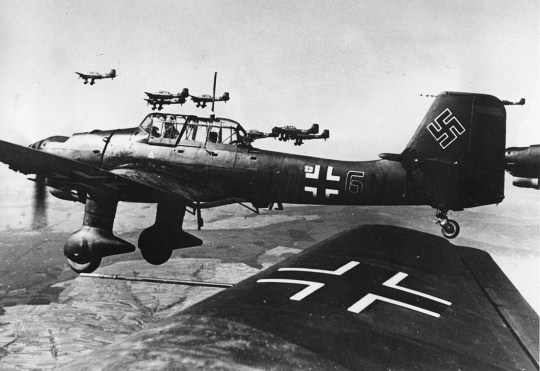
Junkers Ju 87B Stukas, invasion of France, 29 May 1940. For more, see my Facebook group - Eagles Of The Reich
#germany#ww2#luftwaffe#ww2 aircraft#junkers#ju 87#ju 87b#stuka#1940#invasion of france#dive bomber#third reich#nazi germany
55 notes
·
View notes
